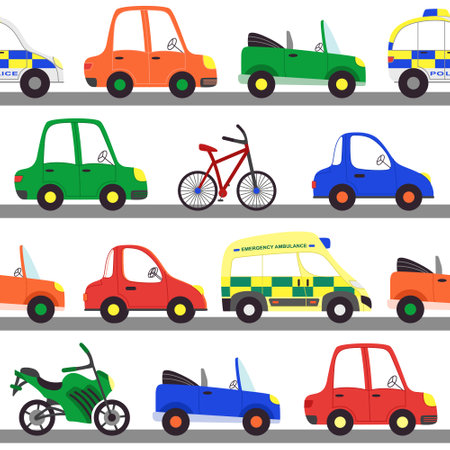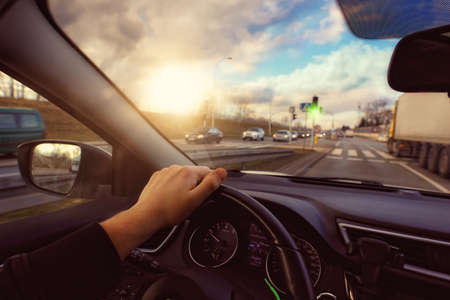1. Understanding Traffic Light Signals
Knowing how to read and respond to traffic lights is essential for safe driving in the United States. Let’s break down what each light means, including flashing signals and turn arrows, so you can avoid common mistakes at intersections.
Standard Traffic Light Colors and Their Meanings
| Light Color | What It Means |
|---|---|
| Green | Go if the intersection is clear. You have the right-of-way, but always check for pedestrians and vehicles before proceeding. |
| Yellow | Caution—slow down and prepare to stop. The light is about to turn red. If you are too close to the intersection to stop safely, you may proceed with caution. |
| Red | Stop completely behind the crosswalk or stop line. Wait until the light turns green before going. |
Flashing Traffic Signals
| Signal Type | What It Means |
|---|---|
| Flashing Red | Treat it like a stop sign: come to a complete stop, then proceed when safe. |
| Flashing Yellow | Slow down and be alert. You do not need to stop, but use extra caution as cross traffic may not have a stop signal. |
Understanding Turn Arrows
Solid Green Arrow:
You may turn in the direction of the arrow; this is a protected turn, meaning oncoming traffic must yield.
Flashing Yellow Arrow:
You may make the turn, but you must yield to oncoming traffic and pedestrians first. Proceed with caution.
Red Arrow:
No turning allowed in the direction of the arrow until it turns green or flashing yellow.
The Bottom Line on U.S. Traffic Lights
Each light and arrow has a specific meaning designed to keep traffic moving safely and smoothly. Always stay alert at intersections, obey the signals, and know that different states might have slight variations, but these rules apply across most of the U.S.
2. Right Turns on Red: When Is It Legal?
Understanding the Basics
Making a right turn at a red light is something many drivers in the U.S. do every day, but there are important rules and exceptions you need to know. In most states, turning right on red is allowed after you come to a complete stop, unless there’s a sign that says otherwise. However, this simple rule comes with details that often trip up even experienced drivers.
Key Rules for Right Turns on Red
| Rule | Description |
|---|---|
| Complete Stop Required | You must always stop fully before turning right on red. Rolling stops are illegal. |
| No Turn on Red Signs | If you see a sign saying “No Turn on Red,” you must wait for the green light. |
| Yield to Others | You must yield to all pedestrians and other vehicles with the right of way. |
| Local Exceptions | Some cities or intersections may have special rules, so always check for posted signs. |
Recognizing Important Signage
The most common sign you’ll see is “No Turn on Red.” This means you cannot turn right at the red light under any circumstances at that intersection. Sometimes, these restrictions are only during certain hours—look for additional wording like “7 AM – 7 PM” under the main sign. If there’s no sign, and it’s safe, you can usually make the turn after stopping and yielding.
Common Misinterpretations
- Assuming it’s always allowed: Not every intersection allows right turns on red. Always look for signage.
- Not stopping completely: Many drivers slow down but don’t fully stop, which is still considered running a red light.
- Forgetting to yield: Pedestrians crossing with a walk signal always have the right of way—even if your light is red and you’re turning right.
- Mistaking left turns for right turns: In almost every state, left turns on red from a one-way street onto another one-way street are sometimes permitted, but not from two-way streets. Don’t confuse this with standard right-on-red rules.
Quick Tips Before Turning Right on Red
- Always check for signs and traffic signals specific to your lane.
- Make a full stop behind the white line before turning.
- Look both ways—watch for cross traffic and pedestrians.
- If in doubt, wait for the green light—it’s safer and avoids tickets.

3. Left Turns and Protected/Permissive Signals
Understanding Protected vs. Permissive Left Turns
When driving in the U.S., making a left turn at intersections can be tricky, especially with different traffic signals. Knowing the difference between protected and permissive left turns is essential for safe driving.
Protected Left Turn
A protected left turn means you have a dedicated green arrow that allows you to turn left safely without conflicting with oncoming traffic or pedestrians. The green arrow gives you the right of way, and all other vehicles must yield.
Permissive Left Turn
A permissive left turn happens when you see a regular solid green light (not an arrow). You may turn left, but you must yield to oncoming traffic and pedestrians first. There is no special signal giving you priority, so extra caution is needed.
Quick Comparison: Protected vs. Permissive Left Turns
| Type | Signal Shown | Your Right of Way | What To Do |
|---|---|---|---|
| Protected | Green Arrow | You have the right of way | Turn left when arrow is green; oncoming traffic is stopped |
| Permissive | Solid Green Light | You must yield to oncoming cars & pedestrians | Turn left only if it’s safe; watch for gaps in traffic |
Responding to Green Arrows vs. Solid Green Lights
- If you see a green arrow: Go ahead and make your left turn with confidence, since oncoming cars are stopped by a red light.
- If you see a solid green light: Wait for a clear gap in oncoming traffic and check for pedestrians before turning. Do not rush or assume others will stop for you.
Avoiding Hazardous Mistakes
- Never turn left on a red arrow. This is illegal and dangerous.
- Don’t block the intersection. If you’re waiting for a gap in traffic during a permissive turn, keep your car behind the crosswalk until it’s safe to enter.
- Look for signs: Some intersections use signs like “Left Turn Yield on Green” as reminders that you must yield to others during permissive turns.
Getting comfortable with these rules helps prevent crashes and keeps everyone safer at busy American intersections. Always pay close attention to signals, signage, and the flow of traffic around you!
4. The Rules of the Intersection
Essential Right-of-Way Rules
Understanding who has the right-of-way at intersections is key to staying safe and avoiding tickets. In general, you must always yield to pedestrians in crosswalks and vehicles already in the intersection. When two cars arrive at an intersection at the same time, the car on the right goes first. If you’re turning left, yield to oncoming traffic unless you have a protected green arrow.
| Situation | Who Goes First? |
|---|---|
| Two cars stop at the same time | The car on the right |
| Turning left at a green light (no arrow) | Oncoming traffic goes first |
| Pedestrian in marked or unmarked crosswalk | Pedestrian always has right-of-way |
| Emergency vehicle approaching with lights/siren | Pullover and yield regardless of intersection rules |
Dealing With Four-Way Stops
Four-way stops can be confusing if you’re not sure what to do. Here’s a quick guide:
- The first car to stop at the intersection is the first to go.
- If two cars arrive at the same time, the car on the right goes first.
- If three cars arrive, use a clockwise order starting from the right.
- If everyone seems confused, make eye contact and proceed with caution once it’s your turn.
Quick Tips for Four-Way Stops:
- Don’t rush—take your time to ensure safety for everyone.
- A complete stop means your wheels aren’t moving.
- No rolling stops—these are illegal and dangerous.
Navigating Crosswalks and Bicycle Lanes at Intersections
Bicycle lanes and crosswalks are increasingly common at American intersections. Here’s how to handle them safely:
Bicycle Lanes:
- Always check your mirrors and blind spots before turning across a bike lane.
- You may only enter a bike lane within 200 feet of making a turn, and only after yielding to any bicyclists.
- Never park or stop in a bicycle lane unless signs specifically allow it.
Crosswalks:
- Yield to all pedestrians in both marked and unmarked crosswalks, even if they’re crossing against the light.
- If another car stops for a pedestrian, do not pass that car—it’s likely someone is crossing that you can’t see.
- Stay behind the white line so you don’t block crosswalks while waiting at red lights or stop signs.
5. Common Mistakes and How to Avoid Them
Rolling Stops at Stop Signs
One of the most frequent intersection mistakes is the “rolling stop.” Many drivers slow down at a stop sign but don’t come to a complete stop. In the U.S., traffic laws require you to make a full stop—meaning your vehicle’s wheels must completely stop moving—before the white line or crosswalk. Failing to do so can lead to traffic tickets or accidents.
Tip:
- Always count “one-one thousand, two-one thousand” after your car stops before proceeding.
- Look both ways and check for pedestrians and cyclists before moving forward.
Blocking the Box
“Blocking the box” means stopping in the middle of an intersection because you couldn’t clear it before the light changed. This mistake not only causes gridlock but can also result in a ticket in many U.S. cities.
| What Happens? | How to Avoid It |
|---|---|
| You get stuck in the intersection when the light turns red. | Only enter an intersection if there’s enough space on the other side for your entire vehicle. |
| You block cross traffic and cause frustration for others. | If traffic ahead is backed up, wait behind the stop line until you can clear the intersection safely. |
Distracted Driving at Intersections
Looking at your phone, adjusting music, or even eating while driving can take your attention away from changing lights or pedestrians crossing. Distracted driving is especially risky at intersections where situations change quickly.
Tip:
- Put your phone out of reach while driving.
- Keep both hands on the wheel and eyes on the road when approaching intersections.
- If you need to adjust something, wait until you’re fully stopped and safe to do so.
Misunderstanding Right-of-Way Rules
A lot of confusion happens when drivers aren’t sure who should go first. For example, at a four-way stop in America, the driver who arrives first goes first. If two vehicles arrive at the same time, the one on the right has priority.
| Situation | Who Goes First? |
|---|---|
| Four-way stop, two cars arrive simultaneously | The car on the right goes first |
| You want to turn left and someone else is going straight | The car going straight has right-of-way |
| You’re making a right turn on red (where allowed) | Yield to all other traffic and pedestrians first |
Poor Lane Discipline Near Intersections
Swooping across lanes last minute or being in the wrong lane for your turn can confuse other drivers and cause crashes. In American cities, lane markings and signs will often tell you which lane you should be in well before you reach the intersection.
Tip:
- Plan ahead by reading signs early and getting into the correct lane as soon as possible.
- Avoid sudden lane changes near intersections; signal early if you need to switch lanes.
Safer Driving Habits Start with Awareness
Paying close attention to these common mistakes—and practicing safer habits—will make every trip through an intersection smoother and safer for everyone on the road.


